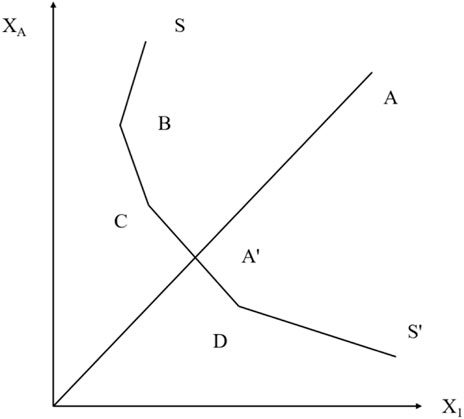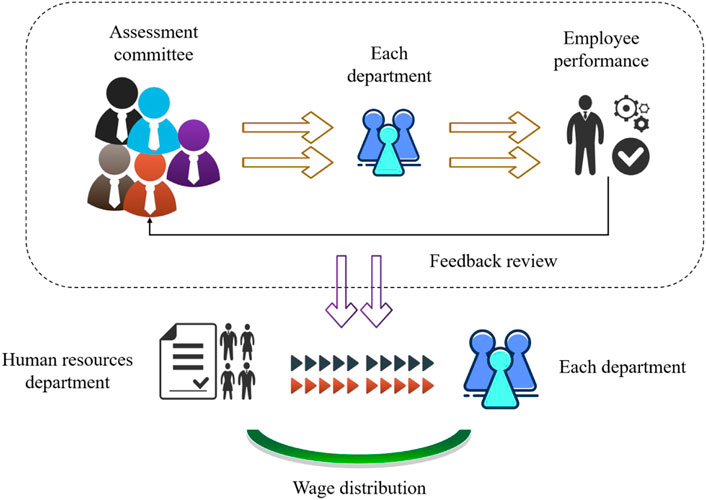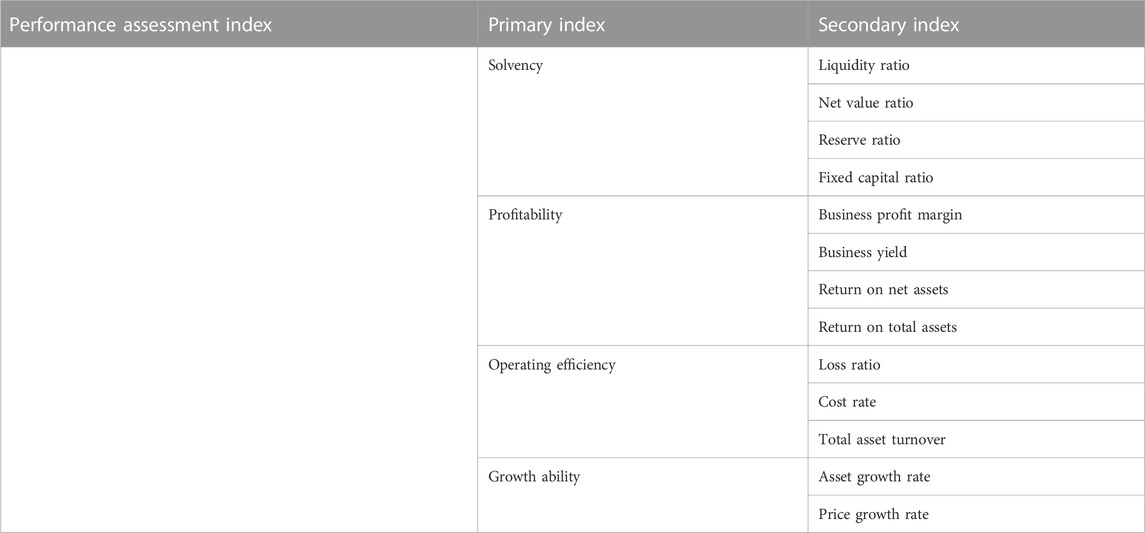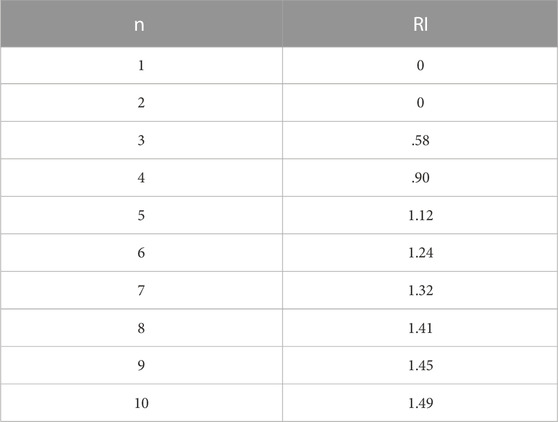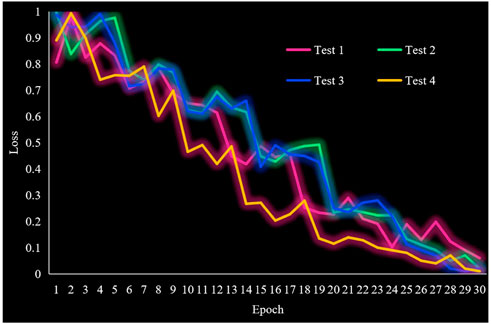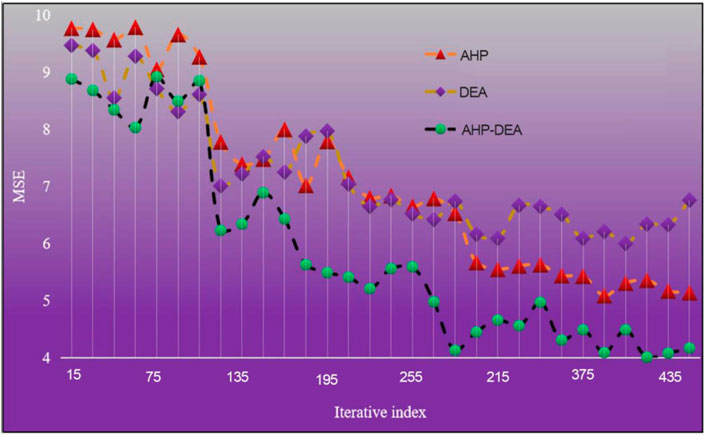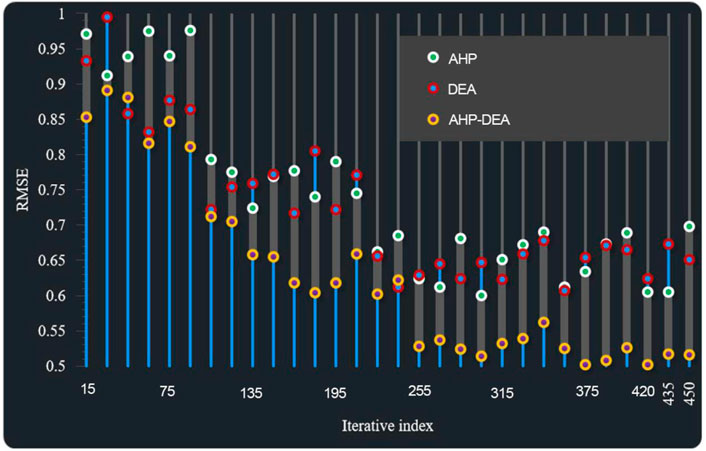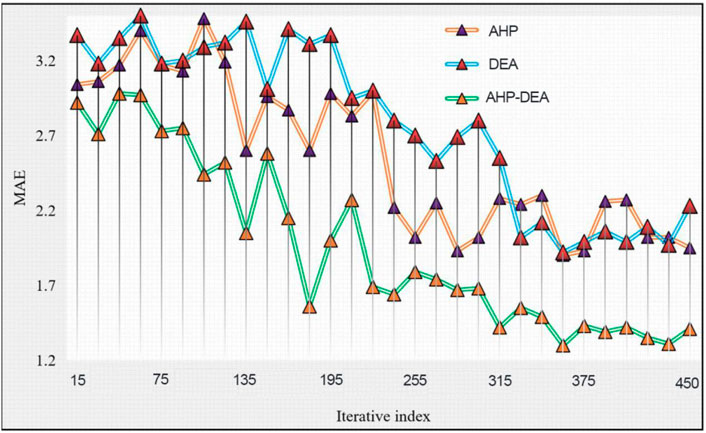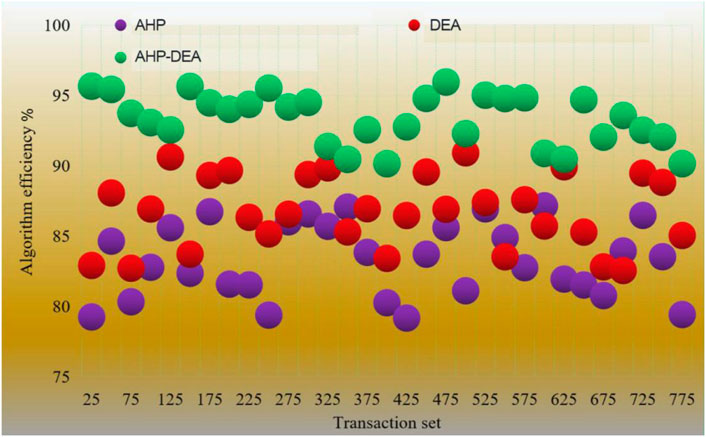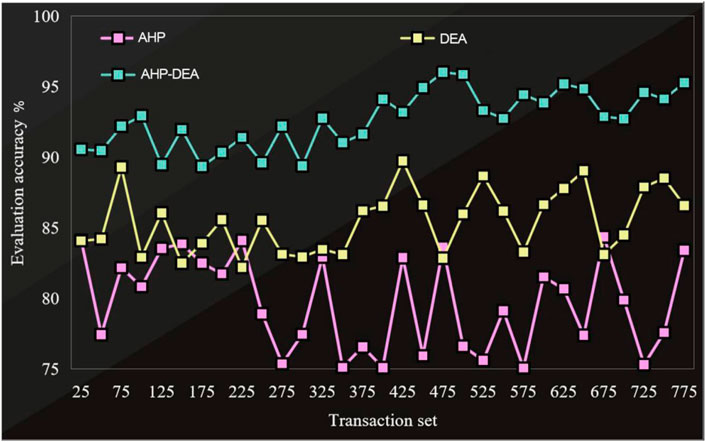- School of Management, Hunan University of Information Technology, Changsha, Hunan, China
With the arrival of the low carbon era, enterprises, as the main body of the market economy, must take the road of low carbon operation whether to fulfill their social responsibilities or to seek enterprise development. However, Chinese enterprises started late to understand the low-carbon economy. So far, except for a few state-owned enterprises, some leading private enterprises and foreign-funded enterprises, they have made remarkable achievements in low-carbon emission reduction. Most enterprises in China have not realized the importance of low carbon emission reduction. In order to step out of the “high carbon” era and coordinate economic development and environmental protection, China must solve the problem of low-carbon transformation of small and medium-sized manufacturing enterprises. How to measure the degree of low carbon transformation, and how the government objectively evaluates the degree of low carbon economic development of enterprises, with a view to formulating corresponding standard incentives and punishment measures for them. It is urgent to establish a sound, reasonable and feasible low carbon operation management indicator system, and comprehensively evaluate the information related to low carbon operation of SMEs through reasonable selection of indicators. According to the connotation of low-carbon enterprises, the economic benefits of enterprises are closely combined with environmental benefits. A set of low carbon operation performance evaluation index system including economy, technology and environment has been constructed. The AHP index weight is calculated by establishing the AHP model and the Data Envelopment Analysis (DEA) index weight is calculated by establishing the DEA model. On this basis, the grey relational evaluation model based on AHP-DEA is established. Then the paper evaluates the performance of representative enterprises’ low carbon operation. Propose corresponding improvement suggestions for the problems reflected in the low carbon operation performance ranking of enterprises and the scoring of various indicators. The research results show that the algorithm has high efficiency and the accuracy of model evaluation is 95.51%. To a certain extent, this study makes up for the research results of the impact of digital transformation on corporate strategic performance, and also provides ideas for the research of corporate financial performance evaluation.
1 Introduction
Under the low-carbon economy, for Chinese enterprises, it means more investment. Unqualified enterprises may be eliminated, but it also contains endless business opportunities, which will promote the better development of enterprises. Therefore, enterprises need to establish an enterprise performance evaluation index system based on low-carbon economy to help enterprises develop in the long run. Under low carbon, performance evaluation must be multi-dimensional and comprehensive (Pflaum and Golzer, 2018). At present, there are no uniform standards and suggestions on how to create an enterprise performance evaluation index system based on a low-carbon economy. And it is not advisable to blindly imitate enterprises in other countries or domestic well-known enterprises. Efforts should be made to build an enterprise performance evaluation index system that takes into account both the situation of the enterprise and low carbon factors (Andriole, 2020). While evaluating the profit of the enterprise, we should take into account the customer, internal operation and employee training, especially the impact of fossil energy consumed by the enterprise to obtain economic benefits on the ecological environment. In the era of low-carbon economy, the traditional enterprise performance evaluation index system must be rebuil. According to the specific situation of each enterprise, in addition to financial indicators, customer indicators, internal business indicators and employee growth indicators, low-carbon environmental indicators must also be added. For example, low carbon economic quality indicators, low carbon economic governance indicators, low carbon policy implementation evaluation indicators and low carbon technology innovation indicators urge enterprises to take the responsibility of environmental protection while pursuing economic interests (Rocha et al., 2021). Enterprises have played a positive role in accumulating social wealth, enriching the market, solving employment, technological innovation, etc. At the same time, due to the low production level, backward equipment, excessive exploitation of resources, serious waste and imperfect management, the production and operation activities of enterprises have become a major factor affecting the environment. In order to step out of the “high carbon” era and coordinate economic development and environmental protection, China must solve the problem of low-carbon transformation of small and medium-sized manufacturing enterprises (Wetering et al., 2021). Then, enterprises should measure the extent of their low-carbon transformation. The government should objectively evaluate the degree of low carbon economic development of enterprises, with a view to formulating corresponding standard incentives and punishment measures for them. Based on this, it is very important to establish a sound, reasonable and feasible low-carbon operation management indicator system (Zhu and Song, 2021). Through reasonable selection of indicators, comprehensively evaluate the information related to low-carbon operation of SMEs, and correctly measure the degree of low-carbon operation of enterprises. The government can effectively control and supervise the low-carbon operation of small and medium-sized enterprises, and help enterprises self check and self reform. It is imperative and urgent to improve the efficiency of government monitoring and evaluation.
Looking at the research on “low carbon,” it is found that most scholars focus on the impact of low carbon economy on the national economy, the importance of developing low carbon economy, and the way to develop low carbon economy. The evaluation of enterprise performance in the low carbon economy is in its infancy. Under the low-carbon economy, enterprises can not unilaterally ignore the economic performance of enterprises in order to reduce carbon dioxide emissions (Bhaskar et al., 2019). We should not just focus on the economic benefits of enterprises for the purpose of making profits and ignore the impact of enterprises on the environment. Enterprises need to improve their economic efficiency on the basis of energy conservation and emission reduction, adjust their energy structure and improve energy efficiency. Therefore, this paper will take small and medium-sized enterprises as the research object, and select the main indicators reflecting the low carbon operation results of enterprises. Build a low carbon operation evaluation index system for enterprises (Ramay et al., 2019). Then, based on the Analytic Hierarchy Process (AHP) model, each indicator of the enterprise’s low-carbon operation performance is processed to obtain the weight of each evaluation element. On this basis, use the gray correlation evaluation model of AHP-DEA to rank enterprises from the perspective of low carbon operation performance, and then put forward the direction that should be improved in the process of low carbon operation.
From the perspective of technology, today’s digital transformation is a transition from industrial civilization to information civilization. The application of these good technologies can change, subvert, or optimize everything we do now. Once the enterprise has mastered the application of new technologies, it will gradually form an acceleration. Strictly speaking, digital transformation has three perspectives. The first is the technical perspective, which is dominated by CIOs or CTOs. The second is the business perspective, which is dominated by business line leaders such as the marketing manager and the manager in charge of R&D. The third perspective is the enterprise perspective, that is, the digital transformation of the enterprise as a whole, which mainly guides entrepreneurs to lead. This paper briefly discusses the impact of digital technology from the three levels of enterprise, enterprise and industry. 1) Business. Digital technology empowers employees and redefines work, and people and machines work together. The machines mentioned here are not only machines and equipment that we can see, but also digital platforms and software applications such as various APPs. 2) Enterprise. All industries will be led by smart enterprises with exponential learning ability. 3) Industry. The business ecology, which takes the platform as the carrier and replaces property rights with digital, will rise in an all-round way. Under the background of digital transformation, the internal control of enterprises faces unprecedented opportunities and challenges. At present, the impact of digital transformation of enterprises on performance is still unclear. More importantly, at present, there are still some problems in the research of digital transformation of enterprises, such as the disunity of theoretical concepts and the incomplete selection of indicators, which also makes the research in this field insufficient (Chen et al., 2019). Good financial condition is the material basis of enterprise operation, and the foundation of sustainable and vigorous growth of enterprises. Therefore, financial performance has always been the focus of research in the field of enterprise performance. The financial performance of an enterprise is an intuitive and comprehensive reflection of its operating results, which is concerned by all stakeholders inside and outside the enterprise. The financial performance level of an enterprise will have a direct or indirect impact on investors’ investment, bank loans, commercial credit of suppliers and customers and even the market share of the enterprise.
The contribution of research and innovation lies in:
1) Build a set of enterprise low carbon business performance evaluation index system. The grey relational evaluation model based on AHP-DEA is established. Then it evaluates the low carbon business performance of representative SMEs.
2) Studied the enterprise digitalization, internal control and financial performance evaluation, and discussed their mechanisms. At the same time, it puts forward the path of strengthening the digitalization of enterprise internal control in the current era.
3) The traditional DEA analysis method is easy to produce deviation and cannot reflect the preference of decision-makers. The grey relational evaluation model of AHP-DEA is adopted to effectively solve the problem that AHP method is easily affected by individual factors of experts. At the same time, according to the problems reflected by the ranking of low carbon business performance and the scoring of various indicators, the paper puts forward the direction for enterprises to improve low carbon business.
The first section of the study elaborates that enterprises should measure the development background of their low-carbon transformation. We should not only focus on the economic benefits of enterprises for the purpose of making profits, but also ignore the impact of enterprises on the environment. Section 2 refers to the technologies that relevant enterprises can use, such as artificial intelligence and the Internet of Things. Further improve the digitalization level of enterprise internal control. Section 3 discusses the content of enterprise digital control performance in low-carbon economy. It is analyzed that the AHP-DEA method of performance appraisal is to improve the performance of each employee, and constantly develop the potential of individuals and teams, so as to improve the performance of enterprises and make them successful. After that, the enterprise performance evaluation based on AHP-DEA model is carried out. Section 4 discusses the conclusion. Section 5 summarizes the full text. The results show that the method in this paper is also conducive to comprehensive analysis and evaluation of the overall comprehensive performance of enterprises, and can truly reflect the actual operation of enterprises. It provides a theoretical reference for enterprises to evaluate the performance of their operating systems, and enables enterprises to continuously improve and develop.
2 Related work
The early definition of enterprise economy is mostly centered on economic benefits and aimed at reducing costs. Economic growth mainly depends on the massive consumption of resources, lacking comprehensive consideration of environmental and social benefits. With the proposal of “low carbon economy,” the early supply chain will inevitably develop into a low carbon supply chain. Low carbon supply chain is a new economic form and development mode. Through technological innovation, institutional innovation, new energy development and other means, we can reduce the consumption of high carbon energy such as coal and oil as much as possible and reduce greenhouse gas emissions. The development of low-carbon supply chain is a global revolution involving production mode, lifestyle, values, national rights and interests and human destiny. On the one hand, enterprises should actively assume the responsibility of environmental protection and meet the requirements of national energy conservation and consumption reduction targets. On the other hand, enterprises should adjust their economic structure, improve energy efficiency, develop emerging industries, and build a low-carbon industrial system. This is a realistic way to abandon the previous development model of “pollution first, treatment later, low-end first, high-end first, extensive first and intensive second,” and is an inevitable choice to achieve win-win economic development and resource and environment protection. It is of great theoretical and practical significance to fully explore and identify the influencing factors and their transmission paths in the low carbon transformation of enterprises, so as to truly implement them and promote enterprise performance. At present, many scholars have discussed this problem. The research of Hu F et al. shows that the higher the degree of low carbon, the higher the level of financial performance (Hu and Yang, 2020). At the same time, internal control plays an intermediary role between enterprise digitalization and financial performance. Christof E and others pointed out that enterprises can use artificial intelligence and the Internet of Things and other technologies to achieve online supervision functions such as real-time monitoring, automatic early warning, supervision and evaluation of internal control systems, and further improve the digitalization level of enterprise internal control (Christof and Duarte, 2018). Kauffman and Weber (2018) believed that in the context of the gradual expansion of the enterprise’s development scale, the importance of its internal control work has become increasingly prominent, and the transformation and upgrading of internal control has become an inevitable trend. Taking the relationship between internal control and performance appraisal as a starting point, Doukidis et al. (2020) deeply analyzed the underlying causes of the enterprise’s development dilemma and put forward relevant suggestions. It provides a good environment for improving performance appraisal. Bhadoria et al. (2017) pointed out that the effectiveness of performance appraisal is affected by internal control to some extent, and performance appraisal can directly affect the implementation of internal control (Kim and Kim, 2017). Zeebaree et al. (2019) examined the impact of performance evaluation purpose on miners’ organizational citizenship behavior. The survey data of miners were analyzed by multiple regression and bootstrap sampling. The results show that both the development purpose and the evaluation purpose of performance evaluation have a positive impact on the overall OCB and its four dimensions through organizational identity. In addition, the relationship between the development purpose of performance evaluation and the overall OCB and its four dimensions is stronger than that of performance evaluation. Enterprises spend a lot of manpower and material resources to establish internal control and performance appraisal, but the main reason for the ineffectiveness is that they ignore the relationship between the two. Therefore, the effective combination of internal control and performance appraisal is particularly important. Harp et al. designed appropriate assessment indicators from the four levels of customer, finance, learning and growth, and internal business in combination with the actual situation; At the same time, through the comprehensive use of AHP method to empower and optimize the indicators of the performance appraisal model, laying the foundation for further performance appraisal (Harp and Barnes, 2018). Although academia is interested in performance management as a key determinant of the effectiveness of enterprise process improvement methods such as Total Quality Management (TQM) and its derivatives, few empirical studies explicitly explore the practice of performance management systems in organizations with a focus on TQM. Soltani and Wilkinson described how organizational and management forces led to the performance management system being unable to accept the core principles of process improvement methods such as TQM (Soltani and Wilkinson, 2020). Huang et al. (2019) conducted a performance evaluation on an enterprise, and linked the problems and causes in the process of enterprise growth in the evaluation process, thus establishing an enterprise performance evaluation index system. Elshaer et al. (2021) bridged the knowledge gap and examined the direct impact of GHRM on the environmental performance of small tourism enterprises and the indirect impact through the environmental friendly behavior of employees. GHRM has an indirect, positive and significant impact on environmental performance through task related and positive environmental behaviors. This reflects the value and important role of employee environmental friendly behaviors in the relationship between GHRM and environmental performance of small tourism enterprises. It provides a new idea for Chinese enterprises to establish a scientific and reasonable performance appraisal index system. Khan et al. (2017) collected the financial data of more than 100 listed companies before and after M&A, and selected more than ten financial indicators for empirical analysis using factor analysis. Gu et al. (2020) found that in the process of performance evaluation, there were significant differences in the perception of organizational justice. To a certain extent, these differences can be explained by the changes in the impact of relationships on executive decision-making. This, in turn, is related to differences in organizational goals between banks and differences within organizations at the departmental level (Gu et al., 2020). Digital dynamic capability and digital innovation are of great significance for textile enterprises to achieve digital transformation performance. Shen et al. (2022) has developed a conceptual model based on the resource capability performance framework to test how the adoption of digital technology, digital dynamic capabilities and digital innovation orientation affect the digital transformation performance of enterprises. The results show that the positive relationship between digital technology adoption and digital transformation performance is not significant; This path is fully realized through digital dynamic capabilities. The digital transformation of enterprises not only reshapes the business model and industrial boundaries, but also boosts the high-quality development of China’s economy. Zhang et al. (2022) reviewed the existing literature and found that digital technology can improve the production efficiency of enterprises by reducing costs, improving efficiency and innovation. Bastari et al. (2020) aimed to examine the impact of transformational leadership on employee performance, with employee motivation as the intermediary variable. The results show that transformational leadership has a significant impact on employees’ job performance, and job motivation is an intervention variable. Employees’ work motivation also has a significant impact on their work performance. The digital business transformation plan is failing due to the gap in understanding the mechanism for enterprises to obtain business value from technology. Organizational readiness is not only the technology, but also the reason for the success of digital transformation. Organizational readiness refers to the ability to use and coordinate core organizational capabilities. Based on the research on the rapid development of digital technology and the advantages of information system discipline in this field, Pappas et al conceptualized the big data and business analysis ecosystem and proposed a model to describe how the big data and business analysis ecosystem paved the way for digital transformation andsustainable society, that is, the digital transformation and sustainable development (DTS) model (Pappas et al., 2018).
This paper takes low-carbon economy and enterprise digital reform as the indicators of reform. Customer satisfaction and residents’ low carbon concept are taken as indicators of social indicator factor layer. Establish a set of performance evaluation index system of low-carbon supply chain with reasonable design and strong operability to provide a strong basis for the development and research of low-carbon supply chain. By analyzing the current situation and existing problems of enterprise performance evaluation system, a set of enterprise financial performance evaluation system is systematically and comprehensively constructed. At the same time, it analyzes the performance evaluation methods of enterprises, and constructs the enterprise performance evaluation model based on AHP-DEA method. Through this model, we can evaluate the financial performance of enterprises, find out deficiencies and put forward suggestions, so as to support enterprises to maintain industrial competitiveness, and also provide ideas for the research of financial performance evaluation.
3 Methodology
3.1 Discussion on digital control performance of enterprises in low carbon economy
Low carbon enterprises refer to enterprises that adjust their energy structure and improve energy efficiency while improving economic returns. In the process of production and operation, reduce the carbon emissions of enterprises as much as possible. Increase the whole industry’s investment in low-carbon technology research and development, create more low-carbon environment-friendly products, and improve the low-carbon competitiveness of enterprises. Reduce the impact of enterprises on the environment, and realize the sustainable development of enterprises and the whole society. It has been 10 years since the low carbon economy was put forward, but the research on low carbon economy mostly focuses on the relationship between energy consumption, economic growth and carbon emissions, lacking systematic analysis of low carbon economy. There are few studies on the evaluation index system and evaluation methods for the low carbon economy system, which makes the concept and policy lack of a bridge to guide the practice of low carbon economy. This paper makes a systematic analysis on various factors involved in the development level of low-carbon economy, aiming to build a performance evaluation system suitable for enterprises in the perspective of low-carbon economy. Carry out comprehensive evaluation and comparison, and propose targeted and clear enterprise development direction (Gu et al., 2020). Therefore, the establishment of this system can provide evaluation basis for the development of low-carbon economy in China in the future, and is conducive to guiding the low-carbon and sustainable development of enterprises.
The design principles of enterprise performance evaluation under the low-carbon economy: 1) Systematic principle. The enterprise performance evaluation under the perspective of low-carbon economy must be comprehensive. Therefore, in terms of index design, comprehensive evaluation of enterprise performance should be made from different perspectives. Among them, basic indicators and evaluation indicators, quantitative indicators and qualitative indicators must be interrelated and mutually restricted to form an organic whole. 2) Principle of goal consistency. The performance evaluation system should be consistent with the enterprise’s development strategy, that is, the medium and long-term goals to be achieved by the enterprise. Only in this way can we correctly play the guiding role of performance evaluation and serve the development of enterprises. The data required for various indicators of enterprise performance evaluation shall be easy to collect and process, that is, the data can be obtained directly or indirectly from the enterprise statistical statements, accounting statements and relevant data reports, so as to reduce the enterprise management costs. 4) The principle of giving consideration to both financial indicators and non-financial indicators. Under the low-carbon economy, the main content of enterprise performance evaluation still needs to be financial performance. However, only setting financial indicators is easy to weaken the pursuit of long-term goals of enterprises, and non-financial evaluation indicators are easy to timely and continuously track enterprise goals. In particular, the introduction of innovation, environment and other factors into the evaluation system is conducive to the optimization of enterprise business processes and the realization of development goals.
Digital transformation, as a transformation mode at the forefront of the digital economy era, has a great demand for technological innovation. Digital transformation strengthens the ability of enterprises to mine and integrate internal and external information, and it will have a higher sensitivity to forward-looking technology, thus helping to grasp the direction of technological innovation and reducing innovation risks. The integration with digital internal control will strengthen the internal control system’s control of business processes and the identification and prevention of risks. In addition, the internal control of enterprises should take into account the operational efficiency while improving the security and reducing the risk of operation and management, otherwise, the internal control will become the fetter of enterprise development. Figure 1 shows the underlying technology and practical application based on enterprise digital transformation.
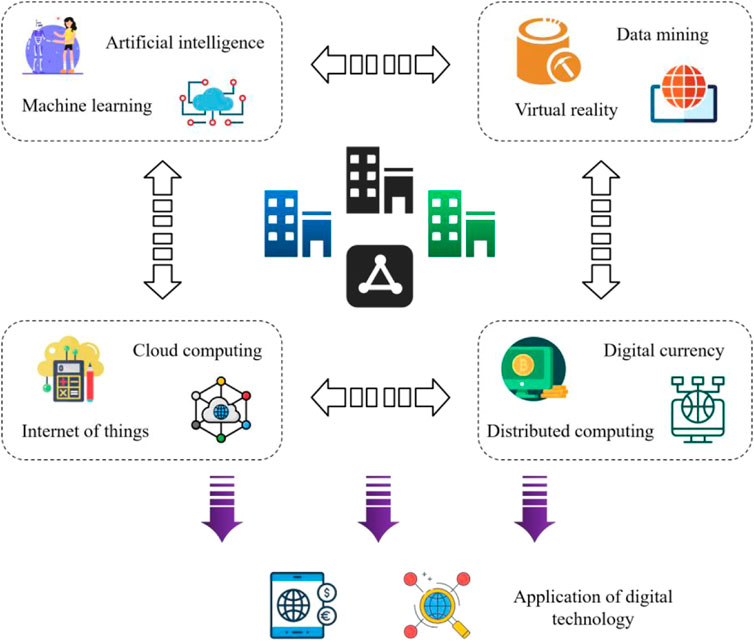
FIGURE 1. The underlying technology and practical application based on enterprise digital transformation.
In the actual business operation, we are exposed to various information such as voice, image, video, document, etc. The information is structured into orders through human intervention, and the work order data enters the IT system one by one. That is, the transformation of unstructured information in the real world, and the realization of structured data that can be understood by IT systems. With various ubiquitous terminals and intelligent applications, the problem of diversification and real-time of data acquisition is really solved. It reduces manual secondary processing and conversion. When enterprises have truly formed such real-time and diverse data resources, they can talk about further value-added applications such as big data storage, big data processing and analysis.
Under the background of digital transformation, enterprises have established corresponding information systems in business fields such as safety management, financial management, marketing, production and operation, human resource management and party building management. Enterprises actively promoting the implementation of digitalization will have an impact on their own organization and management. The implementation of digitalization will bring about changes in enterprise management mode and relationships in organizations. At the same time, the promotion of digitalization will significantly improve the performance level of entity enterprises. The application of digital technology in the internal control system of enterprises strengthens the supervision, control and prediction of production and sales, thus improving the reasonable compliance and efficiency of enterprise operation. At the same time, the internal control system of digital enterprises can find, prevent, reduce or eliminate risks in time, thus improving the financial performance of enterprises. The application of information technology can not only greatly improve the management level of enterprises, but also optimize the internal control effect. If we want to improve the internal environment of enterprises, we must first improve the internal control consciousness of the top management of enterprises. Only the managers of enterprises pay enough attention to internal control, and play an exemplary role, and drive the employees of the whole enterprise with their own fine style, so as to promote the long-term and healthy growth of enterprises. At the same time, enterprises should increase the investment in digitalization and informatization, strengthen the training of digitalization-related talents, integrate internal information systems and platforms, and build several system platforms with mature applications, advanced concepts and perfect functions. Integrate the requirements of internal control into the system platform to improve the digitalization, informationization and systematization level of internal control management.
3.2 AHP-DEA method
According to the analytic hierarchy process, we can get the importance of different indicators of the scheme level to the target level—enterprise performance evaluation. In the standard layer, profitability has the largest weight and the largest impact on financial performance evaluation. The weight of operation capacity is the smallest; In the scheme layer, the current ratio has the largest weight, the largest impact on financial performance evaluation, and the cost of sales ratio has the smallest weight. Therefore, it is feasible to adopt AHP-DEA financial performance evaluation model. Performance appraisal is to improve the performance of each employee, and constantly develop the potential of individuals and teams, so as to improve the performance of enterprises and make them succeed. Essentially, both of them are effective integration of enterprise resources, and their ultimate goal is the realization of enterprise strategic goals. Choosing the appropriate performance assessment method is the premise of the effective growth of enterprise performance assessment, and it is also the effective guarantee to reduce the error of performance assessment results. The enterprise development strategy made by managers is closely related to the results of performance assessment. DEA is an effective efficiency assessment method. DEA method can be used to deal with the problems of multi-input and multi-output comparison with the same decision-making unit, and the judgment of the relative effectiveness of the decision-making unit can be solved by mathematical methods. DEA is used to express the efficiency of an enterprise by the ratio of various outputs to inputs. This calculation method can effectively ignore the influence of standard cost on different indicators, and it can be used to evaluate the performance of comparable departments or enterprises.
DEA only depends on the data of input index and output index, and evaluates each decision-making unit from the perspective of relative effectiveness. It does not depend on the specific form of production function, especially it can effectively deal with the assessment problems of multiple inputs and multiple output indicators. DEA model can be used to evaluate a certain economic benefit index and social benefit index, and it is also a good analytical tool to evaluate the business situation of enterprises. Assume that the input of a certain operating system is two configurations of
AHP is a model method that combines qualitative indicators with quantitative indicators to study unstructured decision-making strategies. The main core process of this method is to establish a multi-level hierarchical structure model, and its essence is a method of systematic comprehensive research by determining the target weight relationship. The basic method is to construct a judgment matrix through pairwise comparison, and then sort the factors at all levels through consistency test. The specific calculation process of AHP can be described as the following three steps: 1) Establishing hierarchical structure. 2) Construct judgment matrix. 3) Ranking and consistency inspection of criteria layer. In this paper, AHP is used to determine the weight of each dimension and each index of the balanced scorecard. Through AHP, complex problems can be divided into different levels, and the problems can be simplified. The enterprise performance assessment process is shown in Figure 3.
Hierarchical structure model is mainly composed of three parts: Scheme layer, criterion layer and target layer. The scheme layer refers to the evaluated schemes and measures, etc. Level is the multi-level assessment standard of the scheme; The goal layer is divided into two types: The overall goal and the sub-goal. AHP and DEA are the main components of operational research assessment methods. In order to maintain the objective evaluation of experts on the importance of indicators in AHP method, and integrate the advantages of DEA method on the selection of optimal decision-making scheme. This paper will choose the linear weighting method to obtain the comprehensive weight of the indicators. A preference parameter needs to be introduced here θ (0 ≤ θ ≤ 1), as the proportion of expert opinions. The application of operational research assessment method can effectively avoid the influence of subjective factors on financial performance assessment results, and the algorithm of operational research method can be realized by program, which is practical. Therefore, in order not to affect the managers’ correct judgment of the enterprise’s operating conditions, through research and analysis, this paper uses AHP-DEA method to evaluate the financial performance of enterprises.
3.3 Enterprise performance assessment based on AHP-DEA model
The so-called performance assessment is to analyze the input and output of an enterprise in the process of operation, and evaluate the operation of the enterprise. To evaluate the performance of enterprises, it is necessary to use appropriate methods and strategies to study the data of enterprises, so that enterprises can obtain the maximum input-output ratio. In this paper, the performance assessment indexes are selected reasonably, and the weights of each index are set by AHP, so as to construct a performance assessment system, and explore the effect and path of digital transformation on the strategic performance of enterprises. The principle of systematicness is that the selected assessment indexes should be comprehensive, holistic, relevant and hierarchical, which is the first principle to establish the assessment index system. The assessment index system should include many factors that affect enterprise performance. The AHP assessment index of enterprise performance in this paper is shown in Table 1.
When evaluating financial performance, the economic status of a certain level of an enterprise can be reflected by its corresponding financial indicators. Generally speaking, enterprise performance includes four aspects: asset operation, financial income, debt paying ability and development ability. Considering the characteristics of enterprises, this paper evaluates the performance level of enterprises in terms of solvency, profitability, operating ability, growth ability and investment yield. Because when constructing the matrix, the quantitative values between the two indicators are obtained by issuing questionnaires. Therefore, in order to avoid the influence of objective factors on the judgment of the importance degree of the two factors, this paper judges whether the assignment of the two indicators is reasonable through consistency test, that is, the method of setting
Among them, the greater the
Where
Usually, when
In the assessment of enterprise performance, two enterprises are arbitrarily selected:
Among them,
Total rank random consistency ratio is as follows:
At this time, it is considered that the results of hierarchical total sorting have satisfactory consistency. Make a pairwise comparison between each index, use
Let
Among them,
4 Result analysis and discussion
Low carbon enterprises refer to enterprises that adjust their energy structure and improve energy efficiency while improving economic benefits. In the process of production and operation, reduce the carbon emissions of enterprises as much as possible. Increase enterprises’ investment in low-carbon technology research and development, create more low-carbon environment-friendly products, and improve enterprises’ low-carbon competitiveness. Reduce the impact of enterprises on the environment, and realize the sustainable development of enterprises and the whole society. Therefore, this paper takes small and medium-sized enterprises as the research object. According to the connotation of low-carbon enterprises, the economic benefits of enterprises are closely combined with environmental benefits. Fully absorb and use for reference the advanced theoretical achievements related to the construction of low carbon evaluation system. Following the basic principles of the construction of low carbon operation performance evaluation index system, a set of low carbon operation performance evaluation index system including enterprises is constructed.
This paper systematically and comprehensively constructs a set of enterprise financial performance assessment system, and builds an enterprise performance assessment model based on AHP-DEA method. In this section, the model algorithm is tested experimentally to verify its effectiveness. According to AHP method, dividing enterprise performance assessment indexes plays a guiding role in the process of enterprise performance assessment. The finer the quantitative indicators are, the more obvious the effect on enterprise performance assessment will be, and the better the operation status of the evaluated enterprise can be observed. DEA method requires the number of sample decision-making units, which is too small to meet the calculation requirements.
In this paper, after consulting the literature on environmental performance audit, it is sorted out and summarized. Taking iron and steel enterprises as an example, nearly 60 items in four categories were finally selected. A Iron and Steel Enterprises closely focus on the company’s core values, develop efficient business policies and strategies and effectively implement them. By improving the production efficiency, strengthening the staff’s working ability and improving the company’s management level, we are gradually approaching the strategic goal of “becoming the most competitive steel enterprise in the world.” As far as 2013 is concerned, the overall operation of the company is good and the sales performance is satisfactory, which has occupied a strong leading position in the steel industry. The total operating income of the company in that year was up to 19,003 billion yuan, and the total profit obtained was 8.01 billion yuan, which is very gratifying. Therefore, this paper selects the financial data of Company A from 2010 to 2019. The original data comes from the annual financial report of Company A, and the financial statement of each year is regarded as a DMU. At the same time, this paper also collected a large number of relevant information about A company, such as announcements, news about the company, official website of the company, etc., and integrated the collected relevant information to extract the relevant data that may be used in this paper. Four test sets are used to normalize the data, and then DEAP software is used to calculate and analyze the evaluation results. Figure 4 shows the training results of the algorithm.
Because the collected raw data has negative numbers, there will be some incompatible problems when importing the input-output model, so it is necessary to preprocess the data. After pretreatment, many experiments were carried out. The experimental results of MSE (Mean squared error), RMSE (Root mean square error) and MAE (Mean absolute error) are drawn into a table, as shown in Table 3.
The experimental results of MSE are shown in Figure 5. The experimental results of RMSE are shown in Figure 6. The experimental results of MAE are shown in Figure 7.
From the analysis of the above experimental results, it can be concluded that the MSE, RMSE and MAE values of this method are lower than those of the comparison algorithm.
Firstly, this paper makes it clear whether the model is based on input or output, and when choosing it, it should be controllable and treatable according to the indicators. That is to say, the input or output indicators can be controlled to the maximum extent. In this paper, the input indicators are net fixed assets, main business costs and the number of employees, which are controllable and manageable. Therefore, the model based on input index is adopted in this paper. Figure 8 shows the efficiency of the model. Figure 9 shows the assessment accuracy of the model.
In this section, after data collection, index comparison and analysis, the validity of AHP-DEA model is tested, and finally the results are analyzed. This document determines whether the model is based on input or output. When selecting the model, it should be controlled and processed according to the indicators. Figure 9 shows the evaluation accuracy of the model. The maximum calculated value is 95.51%. Based on the principle and model of AHP-DEA and the establishment of enterprise performance assessment index system, this paper gives the corresponding comprehensive assessment index and calculation method, which is helpful to quantify enterprise performance assessment index. At the same time, the methods in this paper are also conducive to comprehensively analyzing and evaluating the overall comprehensive performance of enterprises, which can truly reflect the actual operation situation of enterprises, and provide theoretical reference for enterprises to evaluate the performance of their operating systems, so that enterprises can continuously improve and develop.
With the continuous growth of China’s economy, the ecological environment has been seriously damaged, which has brought varying degrees of impact on human survival and development. Low carbon economy has become an innovative economic development model proposed by countries around the world to cope with the current environmental situation. As the main body of economic activities, enterprises play an important role in the development of low-carbon economy. In the process of long-term operation and development of enterprises, the level of operation is mainly reflected by the performance evaluation system, which has exposed a series of problems and deficiencies. It is urgent to innovate and improve the enterprise performance evaluation system. Therefore, this paper mainly designs the enterprise performance evaluation system from the perspective of low carbon economy. Based on the economic performance system, it proposes reasonable improvement measures for the existing problems. A scientific and reasonable enterprise performance evaluation system is designed by integrating various influencing factors, so that the business activities of enterprises can be followed by rules and contribute to the cause of environmental protection.
In the process of production and operation, enterprises have caused a great waste of energy and carbon dioxide emissions that are disproportionate to their economic performance. Therefore, the top priority of the company is to use energy scientifically and reasonably, greatly improve the energy efficiency of the enterprise, so as to reduce the excessive consumption of energy by the enterprise. This can not only implement the national policy requirements for energy conservation and emission reduction of enterprises, but also promote the improvement of economic benefits of enterprises to a certain extent. Enterprises should abandon high pollution and low efficiency energy and use sustainable low-carbon and renewable energy technologies and innovative clean energy technologies instead. So as to effectively reduce greenhouse gas emissions. Enterprises should also improve employees’ low carbon awareness and attach importance to and strengthen the training of employees’ skills. Reasonably allocate the human resources of enterprises, so as to improve the labor productivity of enterprises. And then effectively improve the scores of enterprise carbon productivity, energy output elasticity index and other indicators.
5 Conclusion
This paper takes small and medium-sized enterprises as the research object, and closely combines economic benefits with environmental benefits according to the connotation of low-carbon enterprises. A set of low-carbon operation performance evaluation index system for SMEs has been established, which includes five dimensions of economy, technology, energy, facilities and environment. According to the judgment matrix, calculate the maximum eigenvalue and its corresponding eigenvector, and use AHP-DEA method to rank the enterprise performance according to the eigenvector. The experimental results show that the algorithm has high efficiency, and the accuracy of model evaluation is 95.51%. To some extent, this study makes up for the research results of the impact of digital transformation on enterprise strategic performance in the low-carbon economy. By combining the characteristics of AHP model and DEA model, a gray correlation evaluation model based on AHP-DEA is established. Then evaluate the low-carbon operation performance of five representative SMEs. Through empirical analysis, it is found that the grey relational evaluation model of AH-DEA is used in this paper to effectively solve the problem that AHP method is easy to be affected by experts’ personal factors and cause bias. And the traditional DEA analysis method can not reflect the preference of decision makers. At the same time, this paper puts forward the direction that enterprises should improve their low-carbon operation based on the problems reflected by the ranking of enterprises’ low-carbon operation performance and the scoring of various indicators.
The study has some limitations, and this study lacks more case studies. In the future, the evaluation results of different enterprises will be compared through research on local SMEs. Reduce the corresponding score of cost indicators such as enterprise production energy intensity, enterprise non-productive building carbon emissions, and per capita carbon emissions.
Data availability statement
The original contributions presented in the study are included in the article/Supplementary Material, further inquiries can be directed to the corresponding author.
Author contributions
The author confirms being the sole contributor of this work and has approved it for publication.
Funding
This work was supported by Subject of Hunan social science achievements Review Committee: Research on the digital transformation path of Hunan small and medium-sized micro enterprises under the action background of “Migrating to Cloud, Using Digital Tools and Enabling Intelligence” (No. XSP22YBC595).
Conflict of interest
The author declares that the research was conducted in the absence of any commercial or financial relationships that could be construed as a potential conflict of interest.
Publisher’s note
All claims expressed in this article are solely those of the authors and do not necessarily represent those of their affiliated organizations, or those of the publisher, the editors and the reviewers. Any product that may be evaluated in this article, or claim that may be made by its manufacturer, is not guaranteed or endorsed by the publisher.
References
Andriole, S. J. (2020). Innovation, emerging technology, and digital transformation. IT Prof. 22 (4), 69–72. doi:10.1109/mitp.2020.2985491
Bastari, A., Eliyana, A., and Wijayanti, T. (2020). Effects of transformational leadership styles on job performance with job motivation as mediation: A study in a state-owned enterprise. Manag. Sci. Lett. 10 (12), 2883–2888. doi:10.5267/j.msl.2020.4.019
Bhadoria, R. S., Chaudhari, N. S., and Tomar, G. S. (2017). The Performance Metric for Enterprise Service Bus (ESB) in SOA system: Theoretical underpinnings and empirical illustrations for information processing. Inf. Syst. 65 (4), 158–171. doi:10.1016/j.is.2016.12.005
Bhaskar, L. S., Schroeder, J. H., and Shepardson, M. L. (2019). Integration of internal control and financial statement audits: Are two audits better than one? Account. Rev. 94 (2), 53–81. doi:10.2308/accr-52197
Chen, Y., Wang, J., Zhu, J., Sherman, H. D., and Chou, S. Y. (2019). How the great recession affects performance: A case of Pennsylvania hospitals using DEA. Ann. Operations Res. 278 (1-2), 77–99. doi:10.1007/s10479-017-2516-1
Christof, E., and Duarte, C. (2018). Digital transformation. IEEE Softw. 35 (4), 16–21. doi:10.1109/ms.2018.2801537
Doukidis, G., Spinellis, D., and Ebert, C. (2020). Digital transformation?A primer for practitioners. IEEE Softw. 37 (5), 13–21. doi:10.1109/ms.2020.2999969
Elshaer, I. A., Sobaih, A. E. E., Aliedan, M., and Azazz, A. M. (2021). The effect of green human resource management on environmental performance in small tourism enterprises: Mediating role of pro-environmental behaviors. Sustainability 13 (4), 1956. doi:10.3390/su13041956
Gu, F., Nolan, J., and Rowley, C. (2020). Organizational justice in Chinese banks: Understanding the variable influence of guanxi on perceptions of fairness in performance appraisal. Asia Pac. Bus. Rev. 26 (2), 169–189. doi:10.1080/13602381.2019.1700622
Harp, N. L., and Barnes, B. G. (2018). Internal control weaknesses and acquisition performance. Account. Rev. 93 (1), 235–258. doi:10.2308/accr-51780
Hu, F., and Yang, J. (2020). A fuzzy performance evaluation model for government websites based on language property and balanced score card. Int. J. Enterp. Inf. Syst. 16 (2), 148–163. doi:10.4018/ijeis.2020040109
Huang, X. L., Chen, G. T., and Lee, E. H. (2019). The moderating effect of internal control on performance of cross-border M&A under the uncertainty of economic policy: Evidence from China. J. Korea Trade 23 (7), 128–146. doi:10.35611/jkt.2019.23.7.128
Kauffman, R. J., and Weber, T. A. (2018). Special section: The digital transformation of vertical organizational relationships. J. Manag. Inf. Syst. 35 (3), 837–839. doi:10.1080/07421222.2018.1481646
Khan, S., Dong, Q., and Zhang, Y. (2017). The impact of green supply chain on enterprise performance: In the perspective of China. J. Adv. Manuf. Syst. 16 (03), 263–273. doi:10.1142/s0219686717500160
Kim, H-D., and Kim, Y. (2017). Corporate social responsibility and internal control effectiveness. Asia-Pacific J. financial Stud. 46 (2), 341–372. doi:10.1111/ajfs.12172
Pappas, I. O., Mikalef, P., Giannakos, M. N., Krogstie, J., and Lekakos, G. (2018). Big data and business analytics ecosystems: paving the way towards digital transformation and sustainable societies. Information Systems and e-Business Management 16 (3), 479–491. doi:10.1007/s10257-018-0377-z
Pflaum, A. A., and Golzer, P. (2018). The IoT and digital transformation: Toward the data-driven enterprise. IEEE Pervasive Comput. 17 (1), 87–91. doi:10.1109/mprv.2018.011591066
Ramay, W. Y., Xu, C. Y., and Illahi, I. (2019). Keyword extraction from social media via AHP. Hum. Syst. Manag. 37 (4), 463–468. doi:10.3233/hsm-180344
Rocha, C., Quandt, C., Deschamps, F., Philbin, S., and Cruzara, G. (2021). Collaborations for digital transformation: Case studies of industry 4.0 in Brazil. IEEE Trans. Eng. Manag. 2021 (99), 1–15. doi:10.1109/tem.2021.3061396
Shen, L., Zhang, X., and Liu, H. (2022). Digital technology adoption, digital dynamic capability, and digital transformation performance of textile industry: Moderating role of digital innovation orientation. Manag. Decis. Econ. 43 (6), 2038–2054. doi:10.1002/mde.3507
Soltani, E., and Wilkinson, A. (2020). TQM and performance appraisal: Complementary or incompatible? Eur. Manag. Rev. 17 (1), 57–82. doi:10.1111/emre.12317
Wetering, R., Kurnia, S., and Kotusev, S. (2021). The role of enterprise architecture for digital transformations. Sustainability 13 (2237), 1–5. doi:10.3390/su13042237
Zeebaree, S. R. M., Shukur, H. M., and Hussan, B. K. (2019). Human resource management systems for enterprise organizations: A review. Periodicals Eng. Nat. Sci. (PEN) 7 (2), 660–669. doi:10.21533/pen.v7i2.428
Zhang, T., Shi, Z. Z., Shi, Y. R., and Chen, N. J. (2022). Enterprise digital transformation and production efficiency: Mechanism analysis and empirical research. Econ. Research-Ekonomska Istraživanja 35 (1), 2781–2792. doi:10.1080/1331677x.2021.1980731
Keywords: AHP-DEA, internal control, digital transformation, enterprise performance assessment, low-carbon economy
Citation: Xie J (2023) Analysis on the digital transformation index system of enterprise’s low carbon business performance based on AHP-DEA. Front. Energy Res. 10:1094440. doi: 10.3389/fenrg.2022.1094440
Received: 10 November 2022; Accepted: 19 December 2022;
Published: 05 January 2023.
Edited by:
Wen-Tsao Pan, Hwa Hsia University of Technology, TaiwanReviewed by:
Sa Li, Pingdingshan University, ChinaYifan Wang, Southeast University, China
Hui Dong, Tangshan Normal University, China
Copyright © 2023 Xie. This is an open-access article distributed under the terms of the Creative Commons Attribution License (CC BY). The use, distribution or reproduction in other forums is permitted, provided the original author(s) and the copyright owner(s) are credited and that the original publication in this journal is cited, in accordance with accepted academic practice. No use, distribution or reproduction is permitted which does not comply with these terms.
*Correspondence: Jie Xie, eGllamllQGhudWl0LmVkdS5jbg==
 Jie Xie
Jie Xie